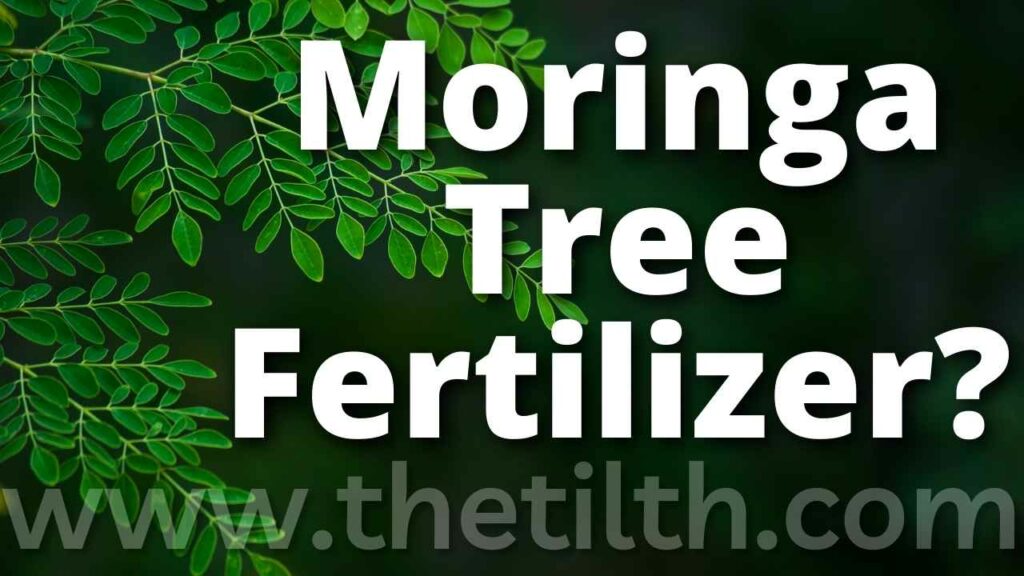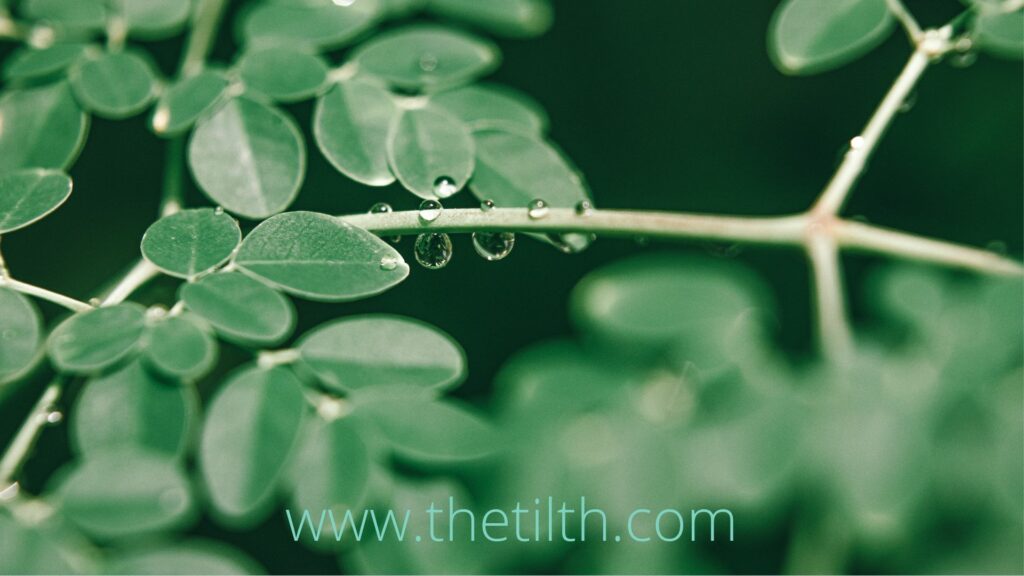Moringa trees are popular with sustainable farmers as they are incredibly drought resistant, require little maintenance, and have incredible nutritional benefits.
Moringa trees respond well to nitrogen heavy organic fertilizers like animal manure and compost. These fertilizers will promote leaf growth and keep your plants bushier. If you are looking to produce more pods or drum sticks you should be sure to include potassium rich fertilizers like potash.
Young moringa trees may benefit from focusing on leaf growth for the first year or two before attempting a fruit harvest.
In India, some farmers will dig holes and line them with leaves, potash, and manure to prepare the spot for a moringa tree transplant.
The holes are filled with the fertilizers, covered and allowed to break down during the rainy season, and used for planting when the dry weather returns.
There was a larger-scale study done in India that showed that the application of manure and ammonium sulfate did increase the tree’s production of pods.
The studies and the amounts used are published in this moringa planting guide by Moringa Farms.

Best Fertilizer for Moringa Trees
Moringa trees can be fertilized with manure and potash to encourage more pod production, but the use of nitrogen-rich manure alone can create bushier plants. Moringa trees are known to be very hardy and require very little maintenance, but they do appreciate regular fertilizer.
Moringa trees are used for their leaves, pods, and seeds. If you are hoping to produce more pods you should use a fertilizer that has plentiful potassium like potash.
The higher alkaline soil is thought to encourage the growth of more pods, or drumsticks as they are sometimes called.
As a general rule, high nitrogen fertilizers encourage leaf production in plants and Moringa generally responds well to nitrogen fertilizers.
It is important to use a balanced fertilizer when fertilizing moringa trees to create healthy soil.
Moringa trees grow best in sandy soil, so fertilizers should be slower to release organic fertilizers like compost, manure, grass clippings, and potash.
Liquid compost formulas will not be well retained in the sandy soil preferred by moringa trees.
Some nurseries use a special tea made of Azomite rock dust to water and add nutrients to the soil around their moringa trees.
Azomite rock dust is mined in bodies of water and is easily dissolved in water. The dust contains minerals like iron, manganese, and zinc that help improve the health of the plant.
Use fertilizers like this when your plants are just becoming established or if you know our soil is very depleted of minerals.
Moringa trees do prefer sandy soil, so you can consider adding this product as a granular fertilizer or dissolving it in water to use as a liquid fertilizer.
You can purchase Azomite rock dust on Amazon for application to your plants. The linked product is mined in Utah and is advertised to help promote the root system.

Best Fertilizer for Starting Moringa Trees in Containers
Moringa trees are incredibly rewarding and easy to grow. Many city dwellers, urban gardeners, and balcony gardeners grow moringa trees in containers.
Start your seeds in any general potting mix and plant them out when they are 6-8 inches tall. When you are selecting your final pot be sure it is at least 18 inches deep to allow for root development.
Moringa trees should be planted in sandy soil with only a small part of peat moss.
You can make this soil mix by combining any soil with sand. The recommended mix is 3 parts soil to one part sand.
Add organic fertilizer like compost, blood meal, or poultry manure to your soil mix at this time or top dress fertilizer as needed.
Choose a nitrogen fertilizer for the first year or two of your tree’s growth to establish strong leaves and help the tree use all the energy to grow.
In the first year consider snipping off flowers to prevent fruiting and encourage strong branch development.
The flowers can be dried and used for tea or eaten fresh in salads. They are good and spicy.
There are some gardeners that recommend against using peat moss in soil, but some find that a small amount is not a problem. Use peat moss in your potting soil at your own risk.
How Do I Keep My Moringa Tree Healthy?
Moringa trees are known to be very easy to grow, but there are a few common problems that can be avoided with proper soil preparation and watering habits.
Watering
Moringa trees need to be watered regularly during the first year or two of their lives.
The trees should be kept moist but not wet.
Do not let the roots sit in wet soil as this can cause root rot and kill your plant.
It is popular to grow moringa trees in containers, and if your plant is in a container be sure that the soil is sandy and drains well. Be sure that the container has a drainage hole that is not blocked.
Climate
Moringa trees are native to India and parts of Africa where the soil is sandy and temperatures rarely dip below 70.
In America, the tree is generally grown in Florida, but it can tolerate conditions in zones 10, 9, and sometimes 8.
If you are outside these zones consider growing the tree in a pot or sturdy greenhouse to protect it from the cold.
Established trees can survive the cold, but the trees will be healthiest in a very warm climate.
Pruning
Moringa trees should be pruned aggressively from the time they start growing.
If you find that your tree is beginning to get spindly and only producing leaves at the top, it needs to be cut back.
You can cut the tree down quite a bit and it will reward you with bushy branches.
Fruits and Flowers
In the first few years of your tree, you may choose to cut off the flowers to prevent fruiting.
Growing the pods or drumsticks takes a lot of energy from the plant. While the plant is growing the fruit it will stop producing leaves to conserve energy for fruiting.
Simply pinch off the flowers if your plant seems to be struggling. The flowers are good for eating fresh or drying into tea.
How To Keep Your Moringa Tree Bushy
Moringa is a super plant, there are benefits of the seeds, the leaves, and the pods. Many farmers prefer to grow the plant for the leaves.
Bushy trees make collecting leaves and fruit easier and they are more attractive in your yard.
Promoting leaf growth requires two things:
Nitrogen in the soil
Frequent Pruning
Nitrogen is known to promote leaf growth in most plants and this is easy to get in fertilizers.
Moringa trees prefer sandy, well-draining soil so consider organic slow-release fertilizers when adding nitrogen to your moringa tree.
Try adding chicken manure, blood meal, compost, and coffee grounds to the top of your soil and mulch over top.
These additions should slowly release nitrogen over time and feed leaf growth.
Fertilizers will not be helpful if you are not strategically pruning your tree.
Moringa trees will grow to be very tall and spindly if they are not pruned aggressively.
Many growers choose to keep the trees between 6 and 8 feet to make harvesting easier.
Unchecked the trees will grow to 35 feet or more, so to keep them shorter and bushier you will need to cut the trees back frequently.
Pruning can be as aggressive as cutting it to an 18 inch to 24-inch stump.
This aggressive pruning is best done in cooler weather when growth is slowing already and the tree is more dormant.
You can also cut individual branches back to keep everything well within reach.
Do not be afraid to cut back branches that are growing where you do not want them. These trees grow an average of 2-3 meters a season so you will have more branches before you know it.
Fertilizing Moringa Trees
As a general rule, Moringa trees will grow well in poor soil with no fertilizer, but the trees will respond well to fertilizer and they may be more important for container grown trees.
Choose a fertilizer that is high in nitrogen for leaf growth and one that is high in potassium to encourage pod growth.
Be sure that you are pruning the tree regularly to help the plant grow optimally and achieve the goals you have for harvesting.
Although moringa trees are very low maintenance, container plants may require more frequent soil amendment as the tree can deplete the soil more quickly.
First, be sure that the pot is at least 18 inches deep and that the soil drains well.
Add fertilizers like compost or blood meal and work it into the top layer of the soil and mulch over the soil.
Moringa trees are very satisfying for the gardner as so many parts of the tree are edible and nutrient rich.
If you are having trouble with your moringa trees remember that they are fast growers and consider grabbing some seeds and growing a small forest.
You can even grow a small bed and clip the young plants for juicing or eating in salads. You do not have to have fully grown trees to benefit from growing this superfood at home.